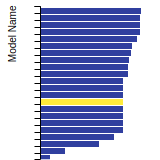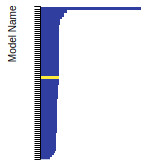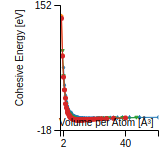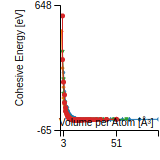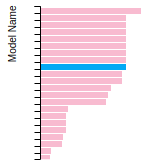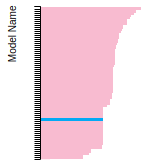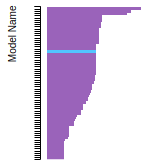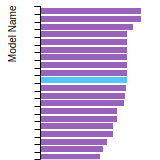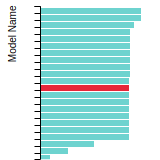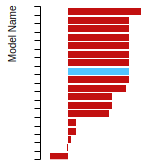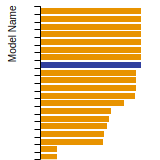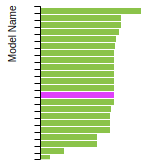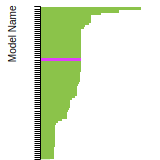 MEAM_LAMMPS_KimLee_2006_PtFe__MO_343168101490_002
MEAM_LAMMPS_KimLee_2006_PtFe__MO_343168101490_002
| Title
A single sentence description.
|
MEAM Potential for the Pt-Fe system developed by Kim, Koo, and Lee (2006) v002 |
|---|---|
| Description
A short description of the Model describing its key features including for example: type of model (pair potential, 3-body potential, EAM, etc.), modeled species (Ac, Ag, ..., Zr), intended purpose, origin, and so on.
|
The potential can describe basic physical properties of the alloys (lattice parameter, bulk modulus, stability of individual phases, and order/disorder transformations), in good agreement with experimental information. The procedure for the determination of potential parameter values and comparisons between the present calculation and experimental data or high level calculation are presented. In original paper (Kim et al., Journal of Materials Research, 21:1, 2006) the applicability of the potential to atomistic studies to investigate structural evolution of Fe50Pt50 alloy thin films during post-annealing is also discussed. |
| Species
The supported atomic species.
| Fe, Pt |
| Disclaimer
A statement of applicability provided by the contributor, informing users of the intended use of this KIM Item.
|
None |
| Content Origin | http://cmse.postech.ac.kr/home_2nnmeam |
| Contributor |
Hyo-Sun Jang |
| Maintainer |
Hyo-Sun Jang |
| Developer |
Jaesong Kim Byeong-Joo Lee |
| Published on KIM | 2023 |
| How to Cite |
This Model originally published in [1] is archived in OpenKIM [2-5]. [1] Kim J, Koo Y, Lee B-J. Modified embedded-atom method interatomic potential for the Fe–Pt alloy system. Journal of materials research. 2006;21(1):199–208. doi:10.1557/JMR.2006.0008 — (Primary Source) A primary source is a reference directly related to the item documenting its development, as opposed to other sources that are provided as background information. [2] Kim J, Lee B-J. MEAM Potential for the Pt-Fe system developed by Kim, Koo, and Lee (2006) v002. OpenKIM; 2023. doi:10.25950/86e43fbf [3] Afshar Y, Hütter S, Rudd RE, Stukowski A, Tipton WW, Trinkle DR, et al. The modified embedded atom method (MEAM) potential v002. OpenKIM; 2023. doi:10.25950/ee5eba52 [4] Tadmor EB, Elliott RS, Sethna JP, Miller RE, Becker CA. The potential of atomistic simulations and the Knowledgebase of Interatomic Models. JOM. 2011;63(7):17. doi:10.1007/s11837-011-0102-6 [5] Elliott RS, Tadmor EB. Knowledgebase of Interatomic Models (KIM) Application Programming Interface (API). OpenKIM; 2011. doi:10.25950/ff8f563a Click here to download the above citation in BibTeX format. |
| Citations
This panel presents information regarding the papers that have cited the interatomic potential (IP) whose page you are on. The OpenKIM machine learning based Deep Citation framework is used to determine whether the citing article actually used the IP in computations (denoted by "USED") or only provides it as a background citation (denoted by "NOT USED"). For more details on Deep Citation and how to work with this panel, click the documentation link at the top of the panel. The word cloud to the right is generated from the abstracts of IP principle source(s) (given below in "How to Cite") and the citing articles that were determined to have used the IP in order to provide users with a quick sense of the types of physical phenomena to which this IP is applied. The bar chart shows the number of articles that cited the IP per year. Each bar is divided into green (articles that USED the IP) and blue (articles that did NOT USE the IP). Users are encouraged to correct Deep Citation errors in determination by clicking the speech icon next to a citing article and providing updated information. This will be integrated into the next Deep Citation learning cycle, which occurs on a regular basis. OpenKIM acknowledges the support of the Allen Institute for AI through the Semantic Scholar project for providing citation information and full text of articles when available, which are used to train the Deep Citation ML algorithm. |
This panel provides information on past usage of this interatomic potential (IP) powered by the OpenKIM Deep Citation framework. The word cloud indicates typical applications of the potential. The bar chart shows citations per year of this IP (bars are divided into articles that used the IP (green) and those that did not (blue)). The complete list of articles that cited this IP is provided below along with the Deep Citation determination on usage. See the Deep Citation documentation for more information. 
33 Citations (16 used)
Help us to determine which of the papers that cite this potential actually used it to perform calculations. If you know, click the .
USED (high confidence) B. Waters, D. S. Karls, I. Nikiforov, R. Elliott, E. Tadmor, and B. Runnels, “Automated determination of grain boundary energy and potential-dependence using the OpenKIM framework,” Computational Materials Science. 2022. link Times cited: 5 USED (low confidence) G.-liang Yu, T.-min Cheng, and X. Zhang, “Effect of pressure on the magnetic, mechanical, and dynamical properties of L10-FePt alloy,” Journal of Applied Physics. 2023. link Times cited: 0 Abstract: The magnetic, elastic, and dynamical properties of L10-type … read more USED (low confidence) Y. Lei et al., “An Embedded-Atom Method Potential for studying the properties of Fe-Pb solid-liquid interface,” Journal of Nuclear Materials. 2022. link Times cited: 1 USED (low confidence) S. Oh, X.-gang Lu, Q. Chen, and B.-J. Lee, “Pressure dependence of thermodynamic interaction parameters for binary solid solution phases: An atomistic simulation study,” Calphad-computer Coupling of Phase Diagrams and Thermochemistry. 2021. link Times cited: 0 USED (low confidence) S. Konorev, R. Kozubski, M. Albrecht, and I. Vladymyrskyi, “Self-diffusion of Fe and Pt in L1-Ordered FePt: Molecular Dynamics simulation,” Computational Materials Science. 2021. link Times cited: 4 USED (low confidence) A. P. Moore, B. Beeler, C. Deo, M. Baskes, and M. Okuniewski, “Atomistic modeling of high temperature uranium–zirconium alloy structure and thermodynamics,” Journal of Nuclear Materials. 2015. link Times cited: 41 USED (low confidence) C. P. Chui, W. Liu, Y. Xu, and Y. Zhou, “Molecular Dynamics Simulation of Iron — A Review.” 2015. link Times cited: 3 Abstract: Molecular dynamics (MD) is a technique of atomistic simulati… read more USED (low confidence) W. Dong, Z. Chen, and B.-J. Lee, “Modified embedded-atom interatomic potential for Co–W and Al–W systems,” Transactions of Nonferrous Metals Society of China. 2015. link Times cited: 9 USED (low confidence) R. Idczak, R. Konieczny, and J. Chojcan, “An enthalpy of solution of chromium in iron studied with 57Fe Mössbauer spectroscopy,” Physica B-condensed Matter. 2012. link Times cited: 21 USED (low confidence) B.-J. Lee, W. Ko, H.-K. Kim, and E.-H. Kim, “The modified embedded-atom method interatomic potentials and recent progress in atomistic simulations,” Calphad-computer Coupling of Phase Diagrams and Thermochemistry. 2010. link Times cited: 137 USED (low confidence) S.-G. Kim et al., “Semi-Empirical Potential Methods for Atomistic Simulations of Metals and Their Construction Procedures,” Journal of Engineering Materials and Technology-transactions of The Asme. 2009. link Times cited: 20 Abstract: General theory of semi-empirical potential methods including… read more USED (low confidence) I. Sa and B.-J. Lee, “Modified embedded-atom method interatomic potentials for the Fe-Nb and Fe-Ti binary systems,” Scripta Materialia. 2008. link Times cited: 48 USED (low confidence) J.-S. Kim and Y. Koo, “Thickness dependence of (001) texture evolution in FePt thin films on an amorphous substrate,” Thin Solid Films. 2008. link Times cited: 25 USED (low confidence) M. Müller, P. Erhart, and K. Albe, “Thermodynamics of L 1 0 ordering in FePt nanoparticles studied by Monte Carlo simulations based on an analytic bond-order potential,” Physical Review B. 2007. link Times cited: 64 Abstract: The size dependence of the order-disorder transition in FePt… read more USED (low confidence) Y.-M. Kim and B.-J. Lee, “A modified embedded-atom method interatomic potential for the Cu–Zr system,” Journal of Materials Research. 2004. link Times cited: 65 USED (low confidence) Y.-M. Kim, Y.-H. Shin, and B.-J. Lee, “Modified embedded-atom method interatomic potentials for pure Mn and the Fe–Mn system,” Acta Materialia. 2009. link Times cited: 64 NOT USED (low confidence) M. Cui et al., “Multi-principal elemental intermetallic nanoparticles synthesized via a disorder-to-order transition,” Science Advances. 2022. link Times cited: 34 Abstract: Nanoscale multi-principal element intermetallics (MPEIs) may… read more NOT USED (low confidence) J.-S. Kim, D. Seol, J. Ji, H.-S. Jang, Y. Kim, and B.-J. Lee, “Second nearest-neighbor modified embedded-atom method interatomic potentials for the Pt-M (M = Al, Co, Cu, Mo, Ni, Ti, V) binary systems,” Calphad-computer Coupling of Phase Diagrams and Thermochemistry. 2017. link Times cited: 31 NOT USED (low confidence) X. Jiang, M. Jiang, and M. Zhao, “Shape effect on the size and dimension dependent order–disorder transition temperatures of bimetallic alloys,” Physica B-condensed Matter. 2011. link Times cited: 10 NOT USED (low confidence) E.-H. Kim, Y.-H. Shin, and B.-J. Lee, “A modified embedded-atom method interatomic potential for Germanium,” Calphad-computer Coupling of Phase Diagrams and Thermochemistry. 2008. link Times cited: 86 NOT USED (high confidence) B. Chen, S. Li, H. Zong, X. Ding, J. Sun, and E. Ma, “Unusual activated processes controlling dislocation motion in body-centered-cubic high-entropy alloys,” Proceedings of the National Academy of Sciences of the United States of America. 2020. link Times cited: 90 Abstract: Significance This work demonstrates dislocation dynamics in … read more NOT USED (high confidence) M. Ångqvist, J. Rahm, L. Gharaee, and P. Erhart, “Structurally driven asymmetric miscibility in the phase diagram of W-Ti,” Physical Review Materials. 2019. link Times cited: 13 Abstract: Phase diagrams for multi-component systems represent crucial… read more NOT USED (high confidence) J. Wei et al., “Modified Embedded Atom Method Potential for Modeling the Thermodynamic Properties of High Thermal Conductivity Beryllium Oxide,” ACS Omega. 2019. link Times cited: 8 Abstract: Modified embedded atom method potential parameters of beryll… read more NOT USED (high confidence) A. von Reppert et al., “Ultrafast laser generated strain in granular and continuous FePt thin films,” Applied Physics Letters. 2018. link Times cited: 15 Abstract: We employ ultrafast X-ray diffraction to compare the lattice… read more NOT USED (high confidence) N. Nakamura, N. Yoshimura, H. Ogi, and M. Hirao, “Elastic constants of polycrystalline L10-FePt at high temperatures,” Journal of Applied Physics. 2013. link Times cited: 8 Abstract: Elastic constants of polycrystalline L10 FePt are studied fr… read more NOT USED (high confidence) R. Konieczny, R. Idczak, J. Elsner, and J. Chojcan, “An enthalpy of solution of platinum in iron studied by 57Fe Mössbauer spectroscopy,” Hyperfine Interactions. 2012. link Times cited: 9 NOT USED (high confidence) R. Konieczny, R. Idczak, J. Elsner, and J. Chojcan, “An enthalpy of solution of platinum in iron studied by 57Fe Mössbauer spectroscopy,” Hyperfine Interactions. 2011. link Times cited: 0 NOT USED (high confidence) N. Nakamura, A. Uranishi, M. Wakita, H. Ogi, M. Hirao, and M. Nishiyama, “Elastic stiffness of L10 FePt thin film studied by picosecond ultrasonics,” Applied Physics Letters. 2011. link Times cited: 12 Abstract: The elastic stiffness of epitaxial and polycrystalline L10 F… read more NOT USED (high confidence) E. Lee and B.-J. Lee, “Modified embedded-atom method interatomic potential for the Fe–Al system,” Journal of Physics: Condensed Matter. 2010. link Times cited: 100 Abstract: An interatomic potential for the Fe–Al binary system has bee… read more NOT USED (high confidence) B.-J. Lee, “A Semi-Empirical Atomistic Approach in Materials Research,” Journal of Phase Equilibria and Diffusion. 2009. link Times cited: 3 NOT USED (high confidence) E. C. Do, Y.-H. Shin, and B.-J. Lee, “Atomistic modeling of III–V nitrides: modified embedded-atom method interatomic potentials for GaN, InN and Ga1−xInxN,” Journal of Physics: Condensed Matter. 2009. link Times cited: 26 Abstract: Modified embedded-atom method (MEAM) interatomic potentials … read more NOT USED (high confidence) J.-S. Kim, Y. Koo, and N. Shin, “The effect of residual strain on (001) texture evolution in FePt thin film during postannealing,” Journal of Applied Physics. 2006. link Times cited: 33 Abstract: Residual strain in a Fe55Pt45 thin film was investigated in … read more NOT USED (high confidence) A. P. Moore, C. Deo, M. Baskes, M. Okuniewski, and D. McDowell, “Understanding the uncertainty of interatomic potentials’ parameters and formalism,” Computational Materials Science. 2017. link Times cited: 17 |
| Funding | Not available |
| Short KIM ID
The unique KIM identifier code.
| MO_343168101490_002 |
| Extended KIM ID
The long form of the KIM ID including a human readable prefix (100 characters max), two underscores, and the Short KIM ID. Extended KIM IDs can only contain alpha-numeric characters (letters and digits) and underscores and must begin with a letter.
| MEAM_LAMMPS_KimLee_2006_PtFe__MO_343168101490_002 |
| DOI |
10.25950/86e43fbf https://doi.org/10.25950/86e43fbf https://commons.datacite.org/doi.org/10.25950/86e43fbf |
| KIM Item Type
Specifies whether this is a Portable Model (software implementation of an interatomic model); Portable Model with parameter file (parameter file to be read in by a Model Driver); Model Driver (software implementation of an interatomic model that reads in parameters).
| Portable Model using Model Driver MEAM_LAMMPS__MD_249792265679_002 |
| Driver | MEAM_LAMMPS__MD_249792265679_002 |
| KIM API Version | 2.2 |
| Potential Type | meam |
| Previous Version | MEAM_LAMMPS_KimLee_2006_PtFe__MO_343168101490_001 |
| Grade | Name | Category | Brief Description | Full Results | Aux File(s) |
|---|---|---|---|---|---|
| P | vc-species-supported-as-stated | mandatory | The model supports all species it claims to support; see full description. |
Results | Files |
| P | vc-periodicity-support | mandatory | Periodic boundary conditions are handled correctly; see full description. |
Results | Files |
| P | vc-permutation-symmetry | mandatory | Total energy and forces are unchanged when swapping atoms of the same species; see full description. |
Results | Files |
| A | vc-forces-numerical-derivative | consistency | Forces computed by the model agree with numerical derivatives of the energy; see full description. |
Results | Files |
| F | vc-dimer-continuity-c1 | informational | The energy versus separation relation of a pair of atoms is C1 continuous (i.e. the function and its first derivative are continuous); see full description. |
Results | Files |
| P | vc-objectivity | informational | Total energy is unchanged and forces transform correctly under rigid-body translation and rotation; see full description. |
Results | Files |
| P | vc-inversion-symmetry | informational | Total energy is unchanged and forces change sign when inverting a configuration through the origin; see full description. |
Results | Files |
| P | vc-memory-leak | informational | The model code does not have memory leaks (i.e. it releases all allocated memory at the end); see full description. |
Results | Files |
| P | vc-thread-safe | mandatory | The model returns the same energy and forces when computed in serial and when using parallel threads for a set of configurations. Note that this is not a guarantee of thread safety; see full description. |
Results | Files |
| P | vc-unit-conversion | mandatory | The model is able to correctly convert its energy and/or forces to different unit sets; see full description. |
Results | Files |
BCC Lattice Constant
This bar chart plot shows the mono-atomic body-centered cubic (bcc) lattice constant predicted by the current model (shown in the unique color) compared with the predictions for all other models in the OpenKIM Repository that support the species. The vertical bars show the average and standard deviation (one sigma) bounds for all model predictions. Graphs are generated for each species supported by the model.
Cohesive Energy Graph
This graph shows the cohesive energy versus volume-per-atom for the current mode for four mono-atomic cubic phases (body-centered cubic (bcc), face-centered cubic (fcc), simple cubic (sc), and diamond). The curve with the lowest minimum is the ground state of the crystal if stable. (The crystal structure is enforced in these calculations, so the phase may not be stable.) Graphs are generated for each species supported by the model.
Diamond Lattice Constant
This bar chart plot shows the mono-atomic face-centered diamond lattice constant predicted by the current model (shown in the unique color) compared with the predictions for all other models in the OpenKIM Repository that support the species. The vertical bars show the average and standard deviation (one sigma) bounds for all model predictions. Graphs are generated for each species supported by the model.
Dislocation Core Energies
This graph shows the dislocation core energy of a cubic crystal at zero temperature and pressure for a specific set of dislocation core cutoff radii. After obtaining the total energy of the system from conjugate gradient minimizations, non-singular, isotropic and anisotropic elasticity are applied to obtain the dislocation core energy for each of these supercells with different dipole distances. Graphs are generated for each species supported by the model.
(No matching species)FCC Elastic Constants
This bar chart plot shows the mono-atomic face-centered cubic (fcc) elastic constants predicted by the current model (shown in blue) compared with the predictions for all other models in the OpenKIM Repository that support the species. The vertical bars show the average and standard deviation (one sigma) bounds for all model predictions. Graphs are generated for each species supported by the model.
FCC Lattice Constant
This bar chart plot shows the mono-atomic face-centered cubic (fcc) lattice constant predicted by the current model (shown in red) compared with the predictions for all other models in the OpenKIM Repository that support the species. The vertical bars show the average and standard deviation (one sigma) bounds for all model predictions. Graphs are generated for each species supported by the model.
FCC Stacking Fault Energies
This bar chart plot shows the intrinsic and extrinsic stacking fault energies as well as the unstable stacking and unstable twinning energies for face-centered cubic (fcc) predicted by the current model (shown in blue) compared with the predictions for all other models in the OpenKIM Repository that support the species. The vertical bars show the average and standard deviation (one sigma) bounds for all model predictions. Graphs are generated for each species supported by the model.
FCC Surface Energies
This bar chart plot shows the mono-atomic face-centered cubic (fcc) relaxed surface energies predicted by the current model (shown in blue) compared with the predictions for all other models in the OpenKIM Repository that support the species. The vertical bars show the average and standard deviation (one sigma) bounds for all model predictions. Graphs are generated for each species supported by the model.
SC Lattice Constant
This bar chart plot shows the mono-atomic simple cubic (sc) lattice constant predicted by the current model (shown in the unique color) compared with the predictions for all other models in the OpenKIM Repository that support the species. The vertical bars show the average and standard deviation (one sigma) bounds for all model predictions. Graphs are generated for each species supported by the model.
Cubic Crystal Basic Properties Table
Species: FeSpecies: Pt
Creators:
Contributor: karls
Publication Year: 2019
DOI: https://doi.org/10.25950/64cb38c5
This Test Driver uses LAMMPS to compute the cohesive energy of a given monoatomic cubic lattice (fcc, bcc, sc, or diamond) at a variety of lattice spacings. The lattice spacings range from a_min (=a_min_frac*a_0) to a_max (=a_max_frac*a_0) where a_0, a_min_frac, and a_max_frac are read from stdin (a_0 is typically approximately equal to the equilibrium lattice constant). The precise scaling and number of lattice spacings sampled between a_min and a_0 (a_0 and a_max) is specified by two additional parameters passed from stdin: N_lower and samplespacing_lower (N_upper and samplespacing_upper). Please see README.txt for further details.
| Test | Test Results | Link to Test Results page | Benchmark time
Usertime multiplied by the Whetstone Benchmark. This number can be used (approximately) to compare the performance of different models independently of the architecture on which the test was run.
Measured in Millions of Whetstone Instructions (MWI) |
|---|---|---|---|
| Cohesive energy versus lattice constant curve for bcc Fe v004 | view | 7171 | |
| Cohesive energy versus lattice constant curve for bcc Pt v004 | view | 7583 | |
| Cohesive energy versus lattice constant curve for diamond Fe v004 | view | 7730 | |
| Cohesive energy versus lattice constant curve for diamond Pt v004 | view | 6694 | |
| Cohesive energy versus lattice constant curve for fcc Fe v004 | view | 7509 | |
| Cohesive energy versus lattice constant curve for fcc Pt v004 | view | 7657 | |
| Cohesive energy versus lattice constant curve for sc Fe v004 | view | 6783 | |
| Cohesive energy versus lattice constant curve for sc Pt v004 | view | 7730 |
Creators: Junhao Li and Ellad Tadmor
Contributor: tadmor
Publication Year: 2019
DOI: https://doi.org/10.25950/5853fb8f
Computes the cubic elastic constants for some common crystal types (fcc, bcc, sc, diamond) by calculating the hessian of the energy density with respect to strain. An estimate of the error associated with the numerical differentiation performed is reported.
| Test | Test Results | Link to Test Results page | Benchmark time
Usertime multiplied by the Whetstone Benchmark. This number can be used (approximately) to compare the performance of different models independently of the architecture on which the test was run.
Measured in Millions of Whetstone Instructions (MWI) |
|---|---|---|---|
| Elastic constants for bcc Fe at zero temperature v006 | view | 20837 | |
| Elastic constants for bcc Pt at zero temperature v006 | view | 48074 | |
| Elastic constants for diamond Fe at zero temperature v001 | view | 69552 | |
| Elastic constants for diamond Pt at zero temperature v001 | view | 61277 | |
| Elastic constants for fcc Fe at zero temperature v006 | view | 22675 | |
| Elastic constants for fcc Pt at zero temperature v006 | view | 22776 | |
| Elastic constants for sc Fe at zero temperature v006 | view | 34234 | |
| Elastic constants for sc Pt at zero temperature v006 | view | 32982 |
Creators:
Contributor: ilia
Publication Year: 2024
DOI: https://doi.org/10.25950/2f2c4ad3
Computes the equilibrium crystal structure and energy for an arbitrary crystal at zero temperature and applied stress by performing symmetry-constrained relaxation. The crystal structure is specified using the AFLOW prototype designation. Multiple sets of free parameters corresponding to the crystal prototype may be specified as initial guesses for structure optimization. No guarantee is made regarding the stability of computed equilibria, nor that any are the ground state.
| Test | Test Results | Link to Test Results page | Benchmark time
Usertime multiplied by the Whetstone Benchmark. This number can be used (approximately) to compare the performance of different models independently of the architecture on which the test was run.
Measured in Millions of Whetstone Instructions (MWI) |
|---|---|---|---|
| Equilibrium crystal structure and energy for FePt in AFLOW crystal prototype A3B_cP4_221_c_a v002 | view | 71780 | |
| Equilibrium crystal structure and energy for FePt in AFLOW crystal prototype AB3_cP4_221_a_c v002 | view | 60274 | |
| Equilibrium crystal structure and energy for FePt in AFLOW crystal prototype AB_tP2_123_a_d v002 | view | 69752 |
Creators:
Contributor: ilia
Publication Year: 2025
DOI: https://doi.org/10.25950/866c7cfa
Computes the equilibrium crystal structure and energy for an arbitrary crystal at zero temperature and applied stress by performing symmetry-constrained relaxation. The crystal structure is specified using the AFLOW prototype designation. Multiple sets of free parameters corresponding to the crystal prototype may be specified as initial guesses for structure optimization. No guarantee is made regarding the stability of computed equilibria, nor that any are the ground state.
| Test | Test Results | Link to Test Results page | Benchmark time
Usertime multiplied by the Whetstone Benchmark. This number can be used (approximately) to compare the performance of different models independently of the architecture on which the test was run.
Measured in Millions of Whetstone Instructions (MWI) |
|---|---|---|---|
| Equilibrium crystal structure and energy for Fe in AFLOW crystal prototype A_cF4_225_a v003 | view | 377563 | |
| Equilibrium crystal structure and energy for Pt in AFLOW crystal prototype A_cF4_225_a v003 | view | 148558 | |
| Equilibrium crystal structure and energy for Fe in AFLOW crystal prototype A_cI2_229_a v003 | view | 148862 | |
| Equilibrium crystal structure and energy for Fe in AFLOW crystal prototype A_hP2_194_c v003 | view | 175434 | |
| Equilibrium crystal structure and energy for Fe in AFLOW crystal prototype A_tP28_136_f2ij v003 | view | 516156 |
Creators:
Contributor: brunnels
Publication Year: 2022
DOI: https://doi.org/10.25950/2c59c9d6
Computes grain boundary energy for a range of tilt angles given a crystal structure, tilt axis, and material.
Creators: Daniel S. Karls and Junhao Li
Contributor: karls
Publication Year: 2019
DOI: https://doi.org/10.25950/2765e3bf
Equilibrium lattice constant and cohesive energy of a cubic lattice at zero temperature and pressure.
| Test | Test Results | Link to Test Results page | Benchmark time
Usertime multiplied by the Whetstone Benchmark. This number can be used (approximately) to compare the performance of different models independently of the architecture on which the test was run.
Measured in Millions of Whetstone Instructions (MWI) |
|---|---|---|---|
| Equilibrium zero-temperature lattice constant for bcc Fe v007 | view | 18479 | |
| Equilibrium zero-temperature lattice constant for bcc Pt v007 | view | 23853 | |
| Equilibrium zero-temperature lattice constant for diamond Fe v007 | view | 20319 | |
| Equilibrium zero-temperature lattice constant for diamond Pt v007 | view | 27166 | |
| Equilibrium zero-temperature lattice constant for fcc Fe v007 | view | 17286 | |
| Equilibrium zero-temperature lattice constant for fcc Pt v007 | view | 22737 | |
| Equilibrium zero-temperature lattice constant for sc Fe v007 | view | 20982 | |
| Equilibrium zero-temperature lattice constant for sc Pt v007 | view | 27976 |
Creators: Daniel S. Karls and Junhao Li
Contributor: karls
Publication Year: 2019
DOI: https://doi.org/10.25950/c339ca32
Calculates lattice constant of hexagonal bulk structures at zero temperature and pressure by using simplex minimization to minimize the potential energy.
| Test | Test Results | Link to Test Results page | Benchmark time
Usertime multiplied by the Whetstone Benchmark. This number can be used (approximately) to compare the performance of different models independently of the architecture on which the test was run.
Measured in Millions of Whetstone Instructions (MWI) |
|---|---|---|---|
| Equilibrium lattice constants for hcp Fe v005 | view | 161155 | |
| Equilibrium lattice constants for hcp Pt v005 | view | 206250 |
Creators:
Contributor: mjwen
Publication Year: 2024
DOI: https://doi.org/10.25950/9d9822ec
This Test Driver uses LAMMPS to compute the linear thermal expansion coefficient at a finite temperature under a given pressure for a cubic lattice (fcc, bcc, sc, diamond) of a single given species.
| Test | Test Results | Link to Test Results page | Benchmark time
Usertime multiplied by the Whetstone Benchmark. This number can be used (approximately) to compare the performance of different models independently of the architecture on which the test was run.
Measured in Millions of Whetstone Instructions (MWI) |
|---|---|---|---|
| Linear thermal expansion coefficient of bcc Fe at 293.15 K under a pressure of 0 MPa v002 | view | 4702581 | |
| Linear thermal expansion coefficient of fcc Pt at 293.15 K under a pressure of 0 MPa v002 | view | 3643552 |
Creators: Matt Bierbaum
Contributor: mattbierbaum
Publication Year: 2019
DOI: https://doi.org/10.25950/64f4999b
Calculates the phonon dispersion relations for fcc lattices and records the results as curves.
| Test | Test Results | Link to Test Results page | Benchmark time
Usertime multiplied by the Whetstone Benchmark. This number can be used (approximately) to compare the performance of different models independently of the architecture on which the test was run.
Measured in Millions of Whetstone Instructions (MWI) |
|---|---|---|---|
| Phonon dispersion relations for fcc Pt v004 | view | 119928 |
Creators:
Contributor: SubrahmanyamPattamatta
Publication Year: 2019
DOI: https://doi.org/10.25950/b4cfaf9a
Intrinsic and extrinsic stacking fault energies, unstable stacking fault energy, unstable twinning energy, stacking fault energy as a function of fractional displacement, and gamma surface for a monoatomic FCC lattice at zero temperature and pressure.
| Test | Test Results | Link to Test Results page | Benchmark time
Usertime multiplied by the Whetstone Benchmark. This number can be used (approximately) to compare the performance of different models independently of the architecture on which the test was run.
Measured in Millions of Whetstone Instructions (MWI) |
|---|---|---|---|
| Stacking and twinning fault energies for fcc Pt v002 | view | 22963338 |
Creators: Matt Bierbaum
Contributor: mattbierbaum
Publication Year: 2019
DOI: https://doi.org/10.25950/6c43a4e6
Calculates the surface energy of several high symmetry surfaces and produces a broken-bond model fit. In latex form, the fit equations are given by:
E_{FCC} (\vec{n}) = p_1 (4 \left( |x+y| + |x-y| + |x+z| + |x-z| + |z+y| +|z-y|\right)) + p_2 (8 \left( |x| + |y| + |z|\right)) + p_3 (2 ( |x+ 2y + z| + |x+2y-z| + |x-2y + z| + |x-2y-z| + |2x+y+z| + |2x+y-z| +|2x-y+z| +|2x-y-z| +|x+y+2z| +|x+y-2z| +|x-y+2z| +|x-y-2z| ) + c
E_{BCC} (\vec{n}) = p_1 (6 \left( | x+y+z| + |x+y-z| + |-x+y-z| + |x-y+z| \right)) + p_2 (8 \left( |x| + |y| + |z|\right)) + p_3 (4 \left( |x+y| + |x-y| + |x+z| + |x-z| + |z+y| +|z-y|\right)) +c.
In Python, these two fits take the following form:
def BrokenBondFCC(params, index):
import numpy
x, y, z = index
x = x / numpy.sqrt(x**2.+y**2.+z**2.)
y = y / numpy.sqrt(x**2.+y**2.+z**2.)
z = z / numpy.sqrt(x**2.+y**2.+z**2.)
return params[0]*4* (abs(x+y) + abs(x-y) + abs(x+z) + abs(x-z) + abs(z+y) + abs(z-y)) + params[1]*8*(abs(x) + abs(y) + abs(z)) + params[2]*(abs(x+2*y+z) + abs(x+2*y-z) +abs(x-2*y+z) +abs(x-2*y-z) + abs(2*x+y+z) +abs(2*x+y-z) +abs(2*x-y+z) +abs(2*x-y-z) + abs(x+y+2*z) +abs(x+y-2*z) +abs(x-y+2*z) +abs(x-y-2*z))+params[3]
def BrokenBondBCC(params, x, y, z):
import numpy
x, y, z = index
x = x / numpy.sqrt(x**2.+y**2.+z**2.)
y = y / numpy.sqrt(x**2.+y**2.+z**2.)
z = z / numpy.sqrt(x**2.+y**2.+z**2.)
return params[0]*6*(abs(x+y+z) + abs(x-y-z) + abs(x-y+z) + abs(x+y-z)) + params[1]*8*(abs(x) + abs(y) + abs(z)) + params[2]*4* (abs(x+y) + abs(x-y) + abs(x+z) + abs(x-z) + abs(z+y) + abs(z-y)) + params[3]
| Test | Test Results | Link to Test Results page | Benchmark time
Usertime multiplied by the Whetstone Benchmark. This number can be used (approximately) to compare the performance of different models independently of the architecture on which the test was run.
Measured in Millions of Whetstone Instructions (MWI) |
|---|---|---|---|
| Broken-bond fit of high-symmetry surface energies in bcc Fe v004 | view | 91483 | |
| Broken-bond fit of high-symmetry surface energies in fcc Pt v004 | view | 145997 |
Creators:
Contributor: efuem
Publication Year: 2023
DOI: https://doi.org/10.25950/fca89cea
Computes the monovacancy formation energy and relaxation volume for cubic and hcp monoatomic crystals.
| Test | Test Results | Link to Test Results page | Benchmark time
Usertime multiplied by the Whetstone Benchmark. This number can be used (approximately) to compare the performance of different models independently of the architecture on which the test was run.
Measured in Millions of Whetstone Instructions (MWI) |
|---|---|---|---|
| Monovacancy formation energy and relaxation volume for bcc Fe | view | 692401 | |
| Monovacancy formation energy and relaxation volume for fcc Pt | view | 340348 |
Creators:
Contributor: efuem
Publication Year: 2023
DOI: https://doi.org/10.25950/c27ba3cd
Computes the monovacancy formation and migration energies for cubic and hcp monoatomic crystals.
| Test | Test Results | Link to Test Results page | Benchmark time
Usertime multiplied by the Whetstone Benchmark. This number can be used (approximately) to compare the performance of different models independently of the architecture on which the test was run.
Measured in Millions of Whetstone Instructions (MWI) |
|---|---|---|---|
| Vacancy formation and migration energy for bcc Fe | view | 815200 | |
| Vacancy formation and migration energy for fcc Pt | view | 3902475 |
| Test | Error Categories | Link to Error page |
|---|---|---|
| Elastic constants for hcp Fe at zero temperature v004 | other | view |
| Elastic constants for hcp Pt at zero temperature v004 | other | view |
EquilibriumCrystalStructure__TD_457028483760_002
| Test | Error Categories | Link to Error page |
|---|---|---|
| Equilibrium crystal structure and energy for FePt in AFLOW crystal prototype A3B_tP4_123_ae_c v002 | other | view |
EquilibriumCrystalStructure__TD_457028483760_003
| Test | Error Categories | Link to Error page |
|---|---|---|
| Equilibrium crystal structure and energy for Fe in AFLOW crystal prototype A_tP1_123_a v003 | other | view |
GrainBoundaryCubicCrystalSymmetricTiltRelaxedEnergyVsAngle__TD_410381120771_003
PhononDispersionCurve__TD_530195868545_004
| Test | Error Categories | Link to Error page |
|---|---|---|
| Phonon dispersion relations for fcc Pt v004 | other | view |
SurfaceEnergyCubicCrystalBrokenBondFit__TD_955413365818_004
| Test | Error Categories | Link to Error page |
|---|---|---|
| Broken-bond fit of high-symmetry surface energies in bcc Fe v004 | other | view |
| Broken-bond fit of high-symmetry surface energies in fcc Pt v004 | other | view |
| MEAM_LAMMPS_KimLee_2006_PtFe__MO_343168101490_002.txz | Tar+XZ | Linux and OS X archive |
| MEAM_LAMMPS_KimLee_2006_PtFe__MO_343168101490_002.zip | Zip | Windows archive |
This Model requires a Model Driver. Archives for the Model Driver MEAM_LAMMPS__MD_249792265679_002 appear below.
| MEAM_LAMMPS__MD_249792265679_002.txz | Tar+XZ | Linux and OS X archive |
| MEAM_LAMMPS__MD_249792265679_002.zip | Zip | Windows archive |
